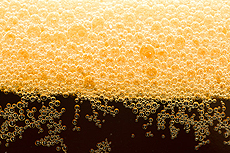Quantum foam
 |
| The foam on a head of root beer is a complicated environment, with bubbles appearing and disappearing in a dizzying display of change. Empty space experiences similar activity, with subatomic particles winking in and out of existence. These ephemeral subatomic particles are real and have a measurable impact on our universe.
|
Modern physics deals with some ridiculously non-intuitive stuff. Objects act as though they gain mass the faster they move. An electron can't decide if it's a particle, a wave or both. However, there is one statement that takes the cake on sounding like crazy talk: Empty space isn't empty.
On the face of it, empty space should be … well … empty. If you take a container, pump all the air out of it, shield it from electric fields and plop it in the deepest of intergalactic space to get it away from gravitational fields, that container should contain absolutely nothing. Nada. Zip.
However, that's not what happens. At the quantum scale, space is a writhing, frantic, ever-changing foam, with particles popping into existence and disappearing in the wink of an eye. This is not just a theoretical idea—it's confirmed. How can this bizarre idea be true?
Even though in classical physics we are taught that energy is conserved, which means it cannot change, one of the tenets of quantum mechanics says that energy doesn't have to be conserved if the change happens for a short enough time. So even if space had zero energy, it would be perfectly OK for a little energy to pop into existence for a tiny split second and then disappear—and that's what happens in empty space. And since energy and matter are the same (thank Einstein for teaching us that E=mc2 thing), matter can also appear and disappear.
And this appears everywhere. At the quantum level, matter and antimatter particles are constantly popping into existence and popping back out, with an electron-positron pair here and a top quark-antiquark pair there. This behavior is the reason that scientists call these ephemeral particles "quantum foam": It's similar to how bubbles in foam form and then pop.
Another name for this phenomenon is "virtual particles," which just means the particles exist only because the rules of the quantum world allow it, and only for a brief time. This phenomenon is also called "zero point energy," and there have been many pseudoscience claims about being able to extract some of this energy. To the best understanding of the scientific community, it is impossible to use it. So beware of any opportunities you encounter that promise you a great return on an investment in a company that claims to exploit zero point energy.
The idea that space is a bubbling brew of ephemeral particles sounds like complete nonsense, but the idea has been confirmed. In 1948, a physicist named Hendrik Casimir realized that if you placed two metal plates near each other, separated by a very small distance, the quantum foam would cause them to move. To visualize this, remember that quantum particles are also waves. Between the plates, only waves (particles) with wavelengths smaller than the separation between the plates can exist. Outside the gap, waves (particles) of all wavelengths can exist. Thus there are more particles outside the gap than inside, and the imbalance pushes the two plates together. This effect has been observed.
Another well-known manifestation of the quantum foam will be studied by Fermilab's proposed Muon g-2 experiment. The muon is a charged particle with a spin of 1/2, and a spinning charged object is a magnet. It is easy to calculate exactly what the strength of the muon magnet should be. When the magnetism of the muon was measured, it was found to be off from the prediction by 0.1 percent—a significant amount, caused by the quantum foam. Physicists are able to calculate the effect of the quantum foam on the muon's magnetism, and it agrees with the theory to incredible precision, better than a part in a billion. The same effect has been seen for electrons as well. This is one of the most precise measurements particle physicists have made and is excellent confirmation of the idea of the quantum foam. On the other hand, there is still a residual discrepancy between the measurement and calculation of the muon's magnetism, which the Muon g-2 experiment intends to study. It may be that the experiment's outcome will change our understanding of the quantum foam, though there are other possibilities.
The quantum foam is real. The microcosm is in continual motion. Scientist J.B.S. Haldane's aphorism is true: "The universe is not only stranger than we imagine, it is stranger than we can imagine."
—Don Lincoln
Want a phrase defined? Have a question? E-mail today@fnal.gov.
|